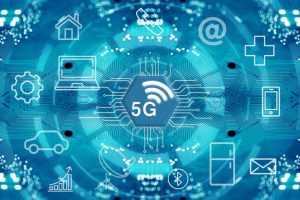 5G Landscape Today
5G Landscape Today
5G represents the fifth generation of wireless mobile technology. It is the next generation of mobile connectivity. 5G is a massive upgrade over its predecessor – 4G and has created a ripple of excitement among the masses over the vast range of promises it has claimed to deliver. 5G is scheduled to furnish a more congenial and communicative Internet of Things (IoT) ecosystem to the masses. The proprietors of this novel technology have waxed lyrical about its capabilities and have not shied away from making promises or giving assurance to their customers. The players include server and antenna manufacturers, transmission equity makers, telecommunications service providers, etc.
IoT includes any object that is connected to the internet and interacts with other connected devices. IoT sensors are connected to IoT platforms that consolidate information from a huge number of devices that collect data and share with each other for better streamlining of information.
5G is set to offer new levels of performance that not only improves the mobile broadband services but also paves the way for enhanced connectivity and efficiency. 5G is expected to provide ultra-fast data feeds (that can peak up to 20Gbps) and very low latency (not more than 1 millisecond). Such low latency will impact industries with IoT devices auto-controlling medical procedures, self-driven cars, etc. 5G will usher in a huge transformation in the industrial sector by connecting all sorts of services. IoT sensors can help in waste management, real-time delivery, traffic monitoring, etc.
A greater number of devices per unit area can be connected to the same high-speed and low latency that will also use better network energy. 5G plans to reduce energy consumption by a staggering 90 percent. This will result in IoT devices having an extended battery life thus benefiting the entire industry. So, it is clear that when we make full use of 5G technology, we will dispense off with wired or cable connections for communication. So, be it a mobile device, HDTVs or smart appliances, we will be going wireless, and there will be no more hassles over wires and cables.
The mobile phone generations have offered huge advancements with each upgrade. 5G is revolutionary. It has the power to cut the monopoly of cable TV providers who provide broadband internet services as well by providing technologies for both internet and cable TV. It can introduce small cell infrastructure as 5G permits tiny transmitters that cover service areas which are smaller compared to its predecessors. These small transmitters will be greater in quantity but their power consumption is lower and occupies less space.
The 5G horizon looks promising as leading companies like Samsung, Nokia, etc. have made public announcements about their ambitions with 5G. Private or local 5G networks will take time to fully bloom into its full potential. Having said that, it is pertinent to note that massive amount of investment needs to be injected to develop such a massive infrastructure.
A comparison with its precursor reveals that 5G is head and shoulders above 4G. 5G is more capable and unlike 4G, it is a unified platform. 5G provides lower latency (up to 10 times), lightning-fast speed, wider use of spectrum, and a bigger capacity than 4G. The average download speed was around 20Mbps in 4G. If 5G is deployed, it can give users download speeds that can range anywhere between 500 Mbps to a whopping 1500 Mbps. 5G spectrum also supports several deployment models, a wide range of bands (low bands < 1 GHz, mid bands 1 Hz – 6 GHz and extremely high-frequency bands up to 300 GHz) and networks like multi-hop mesh environments.
5G aims to lower the data cost by supporting wider use of spectrum in high-frequency bands that includes the millimeter-wave range. 4G LTE was not cost-effective and 5G wants to rectify that. Mobile operators have indulged in offering unlimited data plans these days, and 5G might encourage that even further with a potential increase in data consumption as well. This will make it economically viable to adopt 5G for high-end applications like augmented reality (AR) and virtual reality (VR). Although these were accessible with 4G, the limited amount of traffic and high data costs hindered their usage.
5G and IoT Security: The Possibilities
Greater the rewards, the higher the risks. Cyber-crime has increased manifold these days. This convergence with IoT security is brilliant, but it also seems to redouble cyber security risks to a large extent. With IoT technology making surgical procedures and self-regulating cars a common sight, these risks can become dangerous and even life-threatening. For business organizations, researchers believe proper 5G education is needed to comprehend the practical applications of a 5G network. Potential security threats will be lower if a handful of enterprises start delving deeper into the mechanisms of 5G. A thorough discipline is necessary to acquire the required technical knowledge. IoT devices without a local 5G network might put a business under threat and privacy of employees at high risk.
From the network’s perspective, it is important to have the best IoT device that has the requisite technical standards when it comes to hardware or software. Failure to take advantage of the technological developments in the configuration of applications will not make the best use of 5G security. Therefore, it also rests upon the network operators and IoT device managers on how efficiently they look after security, privacy, compliances with security policies, identities, etc. Therefore, users need to be aware themselves and enterprises can take measures like applying patches of software updates for better security.
But concerns aside, the improvements are hard to ignore. The encryption process has been tweaked and remodelled which has enhanced spoofing features. It has improved upon the anti-tracking feature that puts cyber-criminals at a disadvantage. 5G is cloud-based which makes it easier to spot and terminate potential threats. However, stingray tracking devices will still be able to masquerade successfully and tamper with data.
5G Networks Present Security Vulnerabilities
So, while 5G is flexing its muscles over the revolutionary changes it is about to bring in mobile computing, experts fear that security vulnerabilities of its predecessors have not been fully dealt with by this next-generation wireless network.
The 5 ways 5G is more prone to cyber-attacks and manipulation of data than its forerunners have been enumerated below.
- 5G is software-based and has a distributed digital routing technique. But previous generations were hardware-based and centralized where the “security-enhancing hardware choke points” allowed the creation of critical paths and inspection or quarantine of data packets. This is not possible with 5G.
- Network functions that were performed by physical appliances protected by standard Internet Protocol and trusted operating systems, are now digitalized and packaged in software. This increases the chances of cyber-attack threats.
- The dynamic spectrum sharing (DSS) feature paves the way for extended bandwidth that in turn creates cyber security risks.
- There is an abundance of IoT devices right now. The diversity of features of 5G might not be able to pre-empt these undiscovered avenues to security threats.
- Since 5G is software-based, if any attacker hacks into the software then he/she can gain full control of the network.
While the wide-scale deployment of mobile 5G is a few years away, several companies are actively engaged in the testing and development of 5G equipment to aid in the eventual build-out of 5G networks around the world. Smart Sight Innovations, an IoT development company is carefully monitoring and involved with the development of 5G industry standards.













